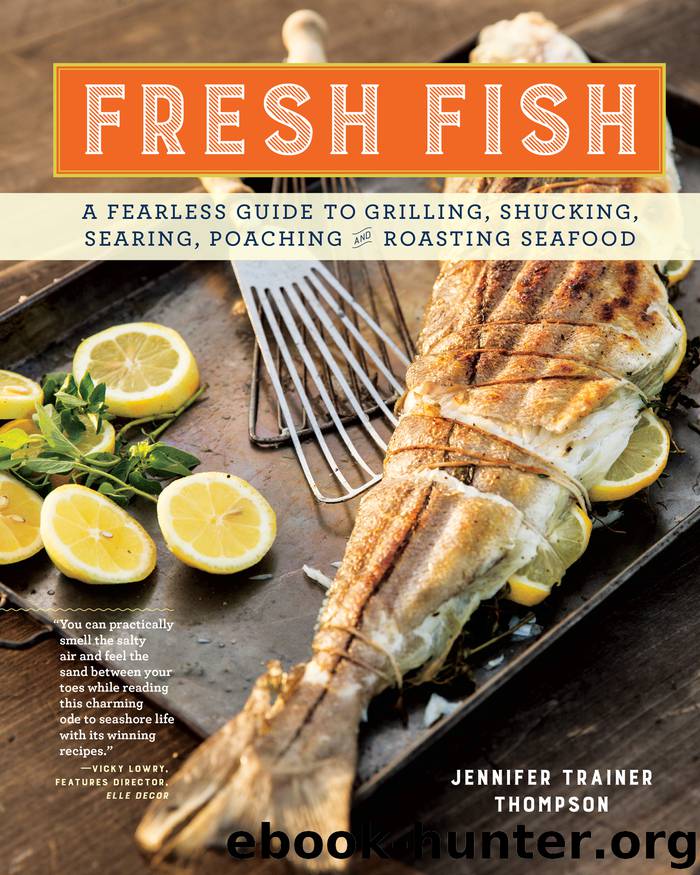Fresh Fish by Jennifer Trainer Thompson

Author:Jennifer Trainer Thompson
Language: eng, eng
Format: epub
Publisher: Storey Publishing
Published: 2016-03-21T19:57:43+00:00
About Mussels
We’ve come a long way since fishermen used mussels for live bait. Cooked extensively in Europe (Julia Child became a big fan in France), mussels have now become fashionable in the U.S., for good reason: easy to gather, these onyx gems are sweet and rich-tasting, high in protein, and a good source of vitamin C, folate, potassium, zinc, iron, phosphorus, and manganese. And did I mention vitamin B12?
In New England, there are two types of mussels: blue and ribbed. With its blue-black shell and violet interior, the delicious northern blue mussel is found in eastern American waters north of the 35th parallel. Grown in Atlantic waters, they’re what you’ll find at a seaside fish market, and if you’re lucky, in the wild, growing in clusters.
But they may not be there the next time you visit — mussel beds are targets for starfish and eider duck predators, and can be wiped out by storms. There used to be a huge natural mussel bed off Nantucket — until one winter a series of storms hit, winds blowing hard from the east all winter long, and one last storm smothered the bed.
Ribbed mussels are similar to blue mussels, but the shell is corrugated and more triangular. You’ll find them clinging in shallow waters to clumps of mud at low tide in the mudflats. Ribbed mussels are critical to the health of a salt marsh, and often are rich in organic bacteria. They’re also not as plump as blue mussels (which have been in deeper waters eating their hearts out). While not poisonous, they are not as tasty, and not often eaten by people.
According to the Cape Cod Commercial Fishermen’s Alliance (their logo is “Small Boats — Big Ideas”), fishing for wild mussels is one of the last wild shellfish operations on the Cape and the Vineyard, with guys going out in small skiffs year-round, landing almost 800 pounds last year. Many mussels today sold in the U.S. are cultivated, with farmed fishing considered largely sustainable and environmentally friendly since shellfish filter water. From Sakonnet Point in Rhode Island to Penobscot Bay in Maine, some mussel farmers have also gone into bottom culture, leasing ocean floor and dropping mesh bags containing mussel seeds that hang nearly 30 feet below the water’s surface. As the mussels grow, the bags deteriorate and they attach to a line.
Today, the United States imports 90 percent of the mussels sold. In Prince Edward Island, with its rural and fishing communities, mussel farming is second only to tourism (aquaculture farms on PEI exported $20 million of blue mussels to the U.S. last year), and many small New England fishermen and organizations are pointing to them as an example of what is possible in developing more offshore farms.
Download
This site does not store any files on its server. We only index and link to content provided by other sites. Please contact the content providers to delete copyright contents if any and email us, we'll remove relevant links or contents immediately.
| Cajun & Creole | California |
| Hawaiian | Mid-Atlantic |
| Midwestern | New England |
| Northwestern | Soul Food |
| Southern | Southwestern |
| Western |
Biscuits: A Savor the South Cookbook by Belinda Ellis(4289)
The French Women Don't Get Fat Cookbook by Mireille Guiliano(3604)
A Jewish Baker's Pastry Secrets: Recipes from a New York Baking Legend for Strudel, Stollen, Danishes, Puff Pastry, and More by George Greenstein(3544)
Better Homes and Gardens New Cookbook by Better Homes & Gardens(3524)
Ottolenghi Simple by Yotam Ottolenghi(3514)
Al Roker's Hassle-Free Holiday Cookbook by Al Roker(3498)
Trullo by Tim Siadatan(3378)
Bake with Anna Olson by Anna Olson(3355)
Hot Thai Kitchen by Pailin Chongchitnant(3320)
Panini by Carlo Middione(3249)
Nigella Bites (Nigella Collection) by Nigella Lawson(3171)
Momofuku by David Chang(3139)
Salt, Fat, Acid, Heat: Mastering the Elements of Good Cooking by Nosrat Samin(3106)
Modern French Pastry: Innovative Techniques, Tools and Design by Cheryl Wakerhauser(3074)
Best of Jane Grigson by Jane Grigson(2944)
Classic by Mary Berry(2941)
Solo Food by Janneke Vreugdenhil(2927)
Tapas Revolution by Omar Allibhoy(2925)
Ottolenghi - The Cookbook by Yotam Ottolenghi(2869)
